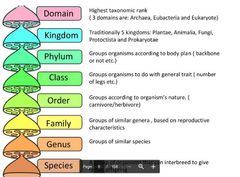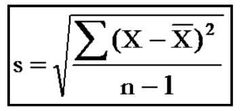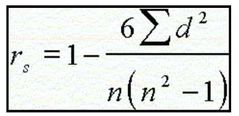![]()
![]()
![]()
Use LEFT and RIGHT arrow keys to navigate between flashcards;
Use UP and DOWN arrow keys to flip the card;
H to show hint;
A reads text to speech;
36 Cards in this Set
- Front
- Back
- 3rd side (hint)
|
Taxonomic Ranking System |

|
Did King Philip Come Over For Good Spaghetti |
|
|
Binomial Naming System |
Organisms are given 2 latin names, universal across countries and languages, the same organisms may have different local names. Firstly it is the genus and then the species e.g Homo sapiens |
|
|
|
Homology |
A traditional biological classification system where organisms are grouped based on the features that they shared. |
|
|
|
Animalia (5 Kingdoms) |
Eukaryotic, No cell wall, Multicellular, Food stored as glycogen, Heterotrophoc (digests large molecules), membrane bound organelles |
e.g Jellyfish, Mammals, worms etc. |
|
|
Plants (5 Kingdoms) |
Eukaryotic, Multicellular, Cellulose Cell wall, use light to produce food by photosynthesis (autotrophic), store food as starch |
e.g algae, ferns, mosses etc. |
|
|
Fungi (5 Kingdoms) |
Eukaryotic, Chitin cell walls, Can be unicellular or multicellular, no chloroplasts, saprophytic feeders, food stored as glycogen |
Moulds, Mushrooms and Yeast. |
|
|
Prokaryotae (5 Kingdoms) |
Prokaryotic, Unicellular, Cells have no nucleus (circular DNA), Absorb nutrients or produce internally via photosynthesis. |
e.g Bacteria |
|
|
Protoctista (5 Kingdoms) |
Eukaryotic, single cell organisms, some have chloroplasts, move using cilia/flagellum, nutrients aquired by photosynthesis (autotrophic) or ingesting other organisms (heterotrophic) or both. |
|
|
|
Phylogeny |
Evolutionary relationships between organisms, it looks at how closely organisms are related. |
|
|
|
Monophyletic |
Belong to the same phylogenetic group e.g Humans and Gorillas. |
|
|
|
Natural Classification |
Includes natural relationships, internal and external features and is based on evolutionary relationships. Evidence is used from DNA sequences and amino acid sequences. |
|
|
|
Using DNA Sequences (Natural Classification) |

Changes in DNA are caused by mutations, the more differences there are the less closely related two species are as they will have evolved seperately for a longer period of time. |
|
|
|
Amino Acid Sequence of Cytochrome C (Natural Classification) |
Cytochrome C is a protein used for respiration, it is not identical in all species. We can compare the sequence of the amino acid in the Cytochrome C protein to find how closely related organisms are. |
|
|
|
The Three Domains |
Bacteria, Archaea, Eukarya |
|
|
|
Features of the Three Domains |

|
|
|
|
Interspecific Variation |
The differences between different species |
|
|
|
Intraspecifc Variation |
The differences between individuals of the same species |
|
|
|
Continuous Variation |
Quantitative - Any feature that can be measured, controlled by both genes and the environment e.g height, length of leaves, number of flagellum. |
|
|
|
Discontinuous Variation |
Qualitative- Any feature that cannot be measured, controlled by genes e.g blood group, eye colour and shape of bacteria. |
|
|
|
Standard Deviation (SD) |
This tells you how much the values in a single sample vary, it shows you a measure of the spread of values about the mean. |
|
|
|
Calculating Standard Deviation (SD) |

|
|
|
|
Spearman's Rank Correlation Coefficient |
This is used to work out whether there is a correlation (a relationship) between a genetic or environmental factor and variation in a particular characteristic. |
|
|
|
Calculating Spearman's Rank Correlation Coefficient |

|
|
|
|
Null Hypothesis |
A Null Hypothesis always suggests that there is no significant correlation between the factors you are investigating |
|
|
|
Anatomical Adaptations |
Body Covering (feathers, hair, scales, spines, shells), Colour (camouflage), teeth - adapted for diet, mimicry- copying another animals appearance to warn predators |
e.g Whales - thick blubber. |
|
|
Physiological Adaptations |
Processes that take place inside an organism e.g Antibiotic production, cacti store water etc. |
|
|
|
Behavioural Adaptations |
Survival, Courtship (attracting a mate) and Seasonal. These can be Innate (genes), learned behaviours or a combination of both. |
|
|
|
Convergent Evolution |
This takes place when unrelated species begin to share similar traits. These similarities evolve because the organisms adapt to similar environments or other selection pressures. |
|
|
|
Evidence to support Evolution |
Palaeontology - study of fossils, Comparative anatomy - study of similarities and differences between organisms, Comparative biochemistry - study of similarities and differences between the chemical make up of organisms. |
|
|
|
Divergent Evolution |
Homologous structure provides evidence that species evolved from a common ancestor. Each species with a different set of adaptive features. |
|
|
|
Gene Pool |
Total number of alleles in a particular population at a specific time |
|
|
|
Allele |
The form of a gene |
|
|
|
Phenotype |
The characteristics of an organism |
|
|
|
Genotype |
The genetic composition of an organism, and the alleles it possesses |
|
|
|
Natural Selection |
The process by which organisms best suited to their environment survive and reproduce, passing on their favourable characteristics to their offspring. |
|
|
|
Antibiotic Resistance |

|
|

